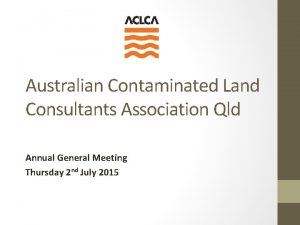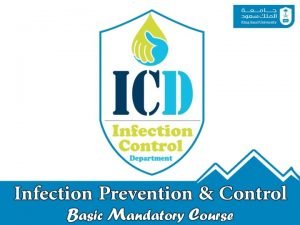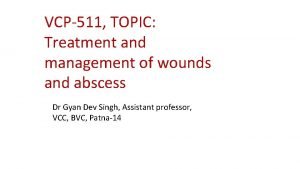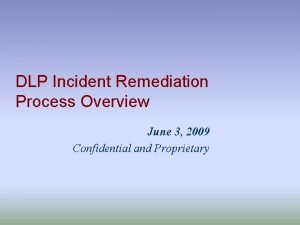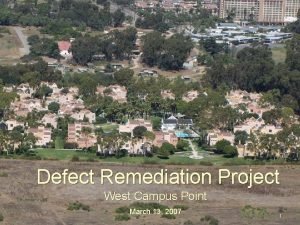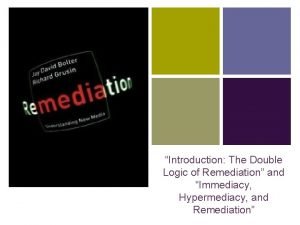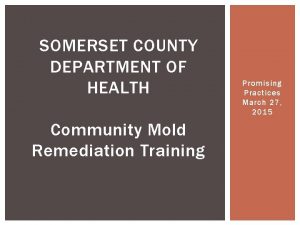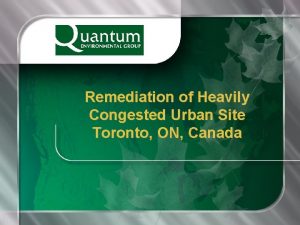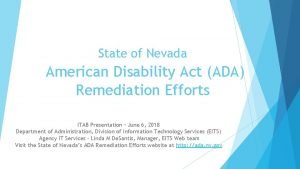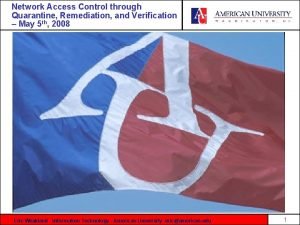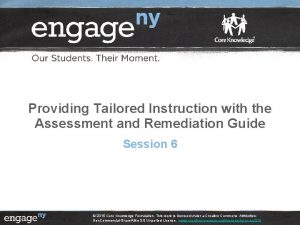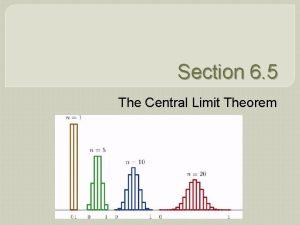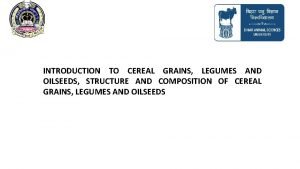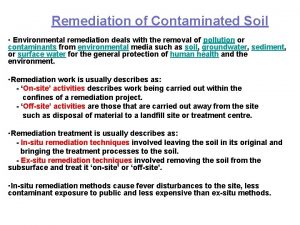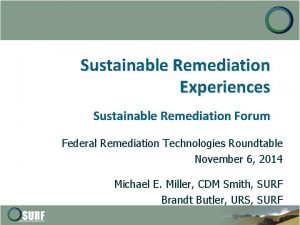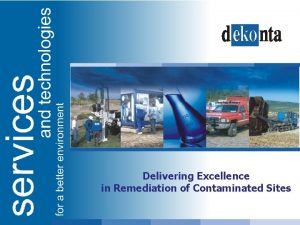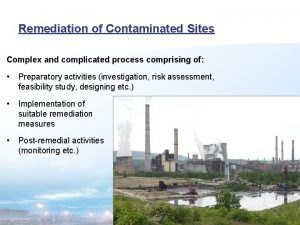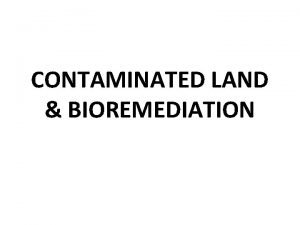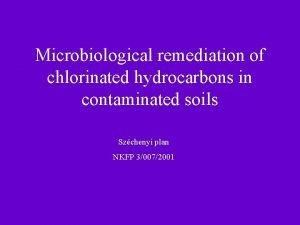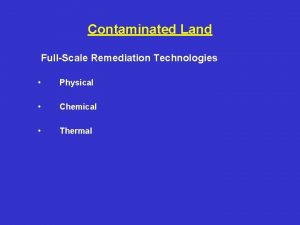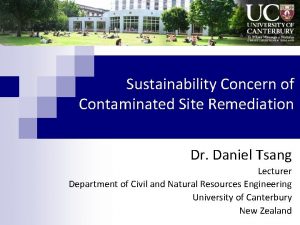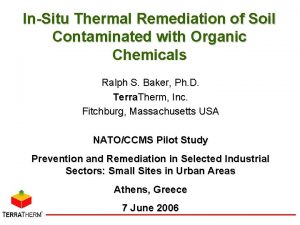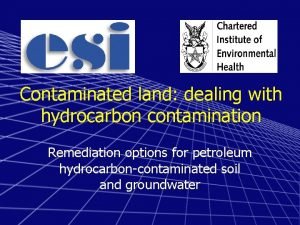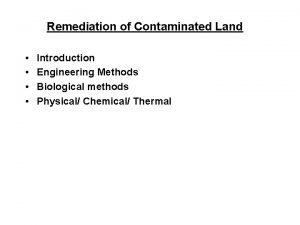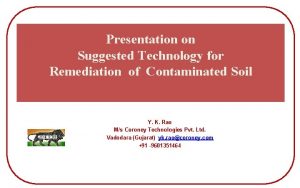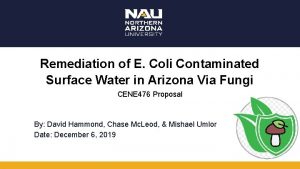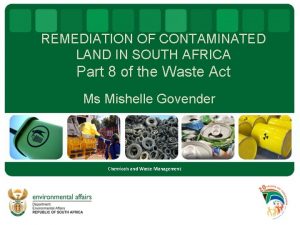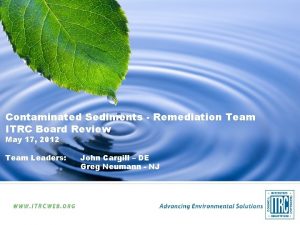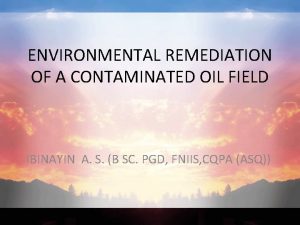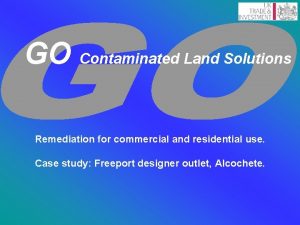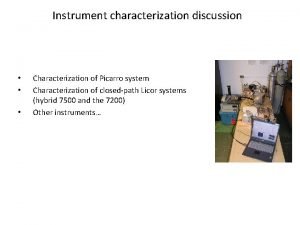Characterization Remediation of Contaminated Sites Aim To illustrate





















- Slides: 21

Characterization & Remediation of Contaminated Sites Aim To illustrate the role of Site Investigations in : Risk Assessment (Site Prioritisation) and Risk Management (Remediation process selection and validation). • Risk Assessment –Site Investigation • Risk Management –Remediation Objectives –Process Selection

Assessing the Risks from Contaminated Land Tools are needed to determine whether: • The soil is uncontaminated. (safe) • The soil is contaminated but presents no unacceptable additional risks to the specified target. (safe) • The soil is contaminated and may present additional risks to the specified target. (further investigation) • The soil is contaminated and presents an unacceptable risk to the defined target. (remediation required)

Overview of Risk Assessment Phased Approach • Collection of Data • Conceptual model (source-pathway-receptor linkages) • Identify and assess Hazards (Site Characterization) • Evaluate and Quantify Risks posed by Hazards – Professional judgement – Generic Guidelines or screening values – Models (site-specific characteristics) • Prioritise sites – fair and transparent process

The Role of Site Investigations in the Remediation Process • Identification of Site • Preliminary Investigation • Planning of Investigation – possible Exploratory Investigation • Main Investigation (Detailed Investigation) • Hazard & Risk Assessment • Identification of Remedial Options • Selection of Preferred Remedial Strategy • Monitor Implementation • Validation • Long-Term Monitoring Phases

Preliminary Investigation • Desk Study – Current Layout - buildings, drains, process areas, plant, services. – Materials - feedstocks, products, wastes – History of the site • Industrial uses • previous incidents • Disposal records – Geology and Hydrology desk study information obtained from: – Maps, photographs, local history, directories, Technical Literature, Local / Government Bodies, residents, workers

Preliminary Investigation • Site Reconnaissance (Site Walkover) – External observation of acute hazards (ruptured tanks, etc) – Visual inspection for Contamination • • discoloured soil, deposits, odours, gas (detection tubes) vegetation - chlorosis, stress condition of fences, metal structures seepage through river banks, land drains – Activities on neighbouring land (on-going) – Confirms Desk Study details (e. g buildings / services/ plant location) – Produce Photographic Evidence • Planning of Subsequent Investigations – Best estimation of the extent of contamination on the site

Exploratory Investigation • Used to confirm presence of contamination where the Preliminary Investigation is inconclusive – Informed sampling locations • Geophysical techniques – Sampling locations • can form Stage 1 of the Main Investigation – Composite samples (surface grab samples) – Soil depth profile samples (Window sampling) – Restricted range of chemical analysis (targeted e. g. BTEX) – helps with Planning of the Main Investigation

Main Investigation • Planning – Safety Procedures • exploring the unknown – Environmental Protection • dust suppression, Wheel wash, decontamination • Sampling – Data Requirements • specific requirements of Regulatory bodies • informed sampling strategy (preliminary investigation) – Methods • augering, window, trial pits and trenches, boreholes

Main Investigation • Chemical Analysis – Quality Assurance • NAMAS (National Measurements Accreditation Service) – Standard Suites (ICRCL) Cd Pb As Cr Zn Hg Chloride Sulphate Sulphide Cyanide sulphur p. H Phenols Toluene extractable Matter (TEM) coal tars mineral oils PAH, PCB, BTEX – Site Specific Contaminants • Interpretation of Data – quantitative risk analysis, prioritisation, remedial targets

Remediation Targets Remediation target values are set by: • Guideline Values (e. g. Background or Threshold) • Site-Specific Risk Values – CLEA Model – Con. Sim Model Practical Considerations include: • • Cost Time Required Technical Feasibility The opinions of the Regulator (LA or EA)

Guidelines and Standards • Standards – system of fixed, legally binding values (not particularly relevant to the soil situation. Why? ) • Guidelines values to be applied with Professional interpretation and judgement. – ICRCL (Interdepartmental Committee on the Remediation of Contaminated Land) – BRE (Building Research Establishment) – Dutch Intervention and Target Values

Guidelines and Standards ICRCL 58/93 Trigger Values (mg/kg air-dried soil) Contaminant Proposed Uses Complex Cyanides PAH Threshold Action Domestic gardens, allotments 250 1000 Landscaped Areas 250 5000 Buildings, hard cover 250 no limit Domestic gardens, allotments, play areas 50 500 Landscaped areas, buildings, hard cover 1000 10, 000

Quantitative Risk Assessment • Human Health – CLEA Model (Contaminated Land Exposure Assessment) – C-soil Model (Netherlands) • Groundwater (Dispersion) – Con. Sim Model (Environment Agency)

Human Health Contaminated Land Exposure Assessment (CLEA) • Site Specific Data – Contaminant concentrations – Climate - precipitation, wind – Soil Properties • • physico-chemical, p. H, redox particle size distribution permeability organic content – Site Use • user activity patterns (visit frequency/duration) – Monte Carlo Exposure Estimate • Probability Density Functions (PDF) • compare with Tolerable Daily Intake (TDI)

Risk to Groundwater Con. Sim Model (Environment Agency) • Determines whether contaminant is likely to exceed WQS value at several locations in the aquifer • Multi-Tiered Approach – (i)Leaching - (ii) Migration - (iii) Dispersion/Diffusion – Tier (iv) for complex geology • Monte Carlo model – input data as PDF (Skill !) – addresses element of uncertainty – decay and biodegradation are calculated – output data graphical

CONTAMINATED SOIL VADOSE ZONE AQUIFER Simulated Leach Data Level 3 Level 2 Dilution Dispersion Biodegradation Unsaturated Zone Retardation Level 1 Theoretical Leach Properties If Concentration < WQS STOP Multi-Tiered Approach of the Con. Sim Model

Multi-Tiered Approach of the Con. Sim Model Contaminant Level 1 Vadose Zone Level 2 Saturated Zone Level 3

Remediation Strategy • Source – permanent reduction of risks – numerous technical approaches • Pathway – risks managed in short to medium term – several different engineering approaches • Target – not usually applicable or practicable

Remediation Technologies non-technical high technology • Soil Disposal Off-Site – Excavation, Landfill • Containment – Capping, Barriers • Restructuring – Redistribution and Dilution of Material • Contaminant Stabilisation, Removal and Destruction – Numerous Biological, Physical, Chemical, Thermal Methods Relatively low cost, and simple. Considerable experience. Expensive, complex, Emerging Technologies

Remediation Technologies • In-Situ Treatment without physically removing the soil – Advantage - less disturbance, emissions, buildings, buried services – Disadvantage - out of sight, monitoring, heterogeneity of contamination, soil structure (occluded clay lenses), mass transfer limitations, toxic hot-spots. • Ex-Situ Treatment after physical removal of soil – Advantage - Mixing distributes contaminants, mass transfer, process control, treat graded fractions, representative sampling, improved rate, protects groundwater. – Disadvantage - more work, space requirement, emissions, avoid buried services, aesthetic appearance

Remediation Technologies • Intensive Process – Aim to achieve a rapid rate of remediatiohn – uses complex equipment – consume considerable resources • power, reactants, labour, monitoring – Generally detrimental to soil structure – Examples - Soil Washing, Incineration • Extensive Process – Slower to Work – Low capital and Maintenance Costs – Soil Structure retained (Improved) – Examples - Phytoremediation, Bioremediation
 Australian contaminated land consultants association
Australian contaminated land consultants association Waste mangment
Waste mangment Contaminated wound
Contaminated wound Contaminated product insurance
Contaminated product insurance Newsworthy event (s) background event (s) sources
Newsworthy event (s) background event (s) sources Direct characterization vs indirect characterization
Direct characterization vs indirect characterization Definition direct characterization
Definition direct characterization Dlp remediation
Dlp remediation Remediation of the struggling medical learner
Remediation of the struggling medical learner Defect remediation
Defect remediation Immediacy hypermediacy and remediation
Immediacy hypermediacy and remediation Somerset mold removal
Somerset mold removal Site remediation toronto
Site remediation toronto Nevada eits
Nevada eits Nac remediation
Nac remediation Sox remediation software
Sox remediation software Remediation plan in change lifecycle
Remediation plan in change lifecycle Ckla assessment and remediation guide
Ckla assessment and remediation guide New taxonomy of marzano and kendall 2007
New taxonomy of marzano and kendall 2007 Central limit theorem
Central limit theorem Invertebrate evolution and diversity 1
Invertebrate evolution and diversity 1 Legumes structure
Legumes structure
